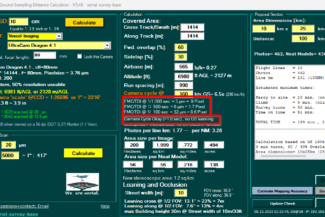GSD Calculator updated:
foot print/array for PhaseOne Pana is now 48.000 x 14.204 pixel.
Due to the further development of camera systems, in particular flash-based storage systems and improved raw data formats, I have adapted the calculations for the camera cycle and associated warning messages.
These are now based on a 1 second camera cycle. actual aerial systems have now a readout time of 0,5 to 0,7 seconds as the image sensor can be emptied, (backlighted) CMOS based sensors are even faster than a CCD.
I have adjusted the FMC/TDI range calculation and pixel shift – we now see the FMC/TDI for 1/1.000, 1/500 & 1/100 sec shutter time.
Modern systems are even faster, shutter times of 1/2.000 is almost standard today when using Bayer pattern sensors. The PhaseOne GS120 allows theoretically even 1/16.000, although 1/8.000 is more normal in everyday flying.
PhaseOne relies on carbon fiber shutter blades, which are of course much lighter and therefore faster than metal blades.
Thanks to Poul of PhaseOne for sending correct values.
A few more technical backgrounds related to image blur:
Image blur caused by high-speed motion is one of the main problems of aerial digital cameras. Removing image blur with special techniques is called Forward Motion Compensation (FMC) or Time Delayed Integration (TDI) techniques.
During the exposure time of the sensor, image of the same earth region moves more than many pixels on the sensor due to high speed, and causes image blur. Expensive TDI (time delay integration) sensors are now available and electronically compensate the motion within the sensor.
TDI – Time Delayed Integration:
A time delay integration (TDI) charge-coupled device (CCD) is an image sensor for capturing images of moving objects at low light levels. It works by synchronized mechanical and electronical scanning, so that the effects of dim imaging targets on the sensor can be integrated over longer periods of time. TDI is more of an operating mode for CCDs than a separate type of CCD device altogether, even if technical optimizations for the mode are also available.
The principle behind TDI—constructive interference between separate observations—is often applicable to other sensor technologies, especially long exposure astronomical observation.
Vexcel and Leica use these technologies in their high-end pan-sharpening systems, such as the DMC and Ultracam Eagle series (premium line cameras)
In a staring CCD array configuration, the image is exposed on the two-dimensional semiconductor surface, and then the resulting charge distribution over each line of the image is moved to the side, to be rapidly and sequentially read out by an electronic read amplifier.
When done fast enough, this produces a snapshot of the applied photonic flux over the sensor; the readout can proceed in parallel over the several lines, and yields a two-dimensional image of the light applied. Along with CMOS detectors which sense the photo charge accumulation pixel by pixel instead of moving the charge out line by line, such sensors are commonly known as parts of digital cameras, from the small to the large.
The time delayed integration (TDI) shift is comparable to the Forward Motion Compensation (FMC) used by analogue film cameras. The TDI mechanism allows the shift of the image in the focal plane dependent from the flying height and the aircraft speed. Under special conditions (e.g. very long exposure times), this shift can be about several dozens of pixels, e.g. a DMC is capable for a 50-pixel shift.
Forward Motion Compensation (FMC):
Another method is to move the sensor linearly, proportional the speed of image walk. This can be provided by piezo-actuators. Some sensors present examples of these mechanical FMC techniques (similar to film-based cameras).
By these methods cheaper standard sensors can be used in digital aerial cameras.

